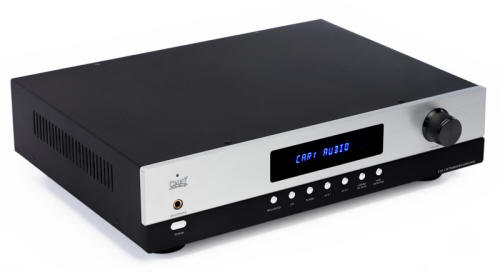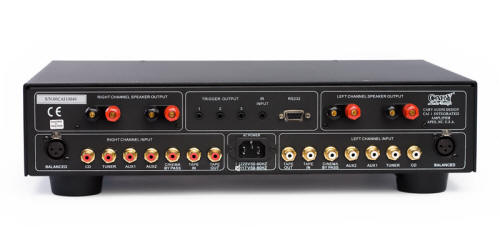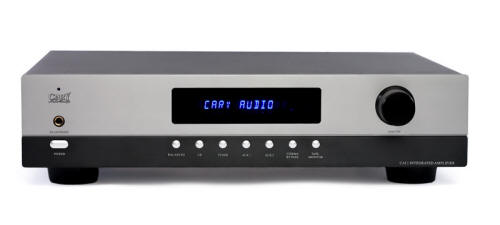
You are reading the older HTML site
Positive Feedback ISSUE
may/june 2007
cary audio
Concept Series CAI 1 integrated
as reviewed by Tom Campbell and a few words by Bob O'Neill

|
TOM CAMPBELL'S SYSTEM
LOUDSPEAKERS
ELECTRONICS
SOURCES
CABLES
ACCESSORIES
|
 Against all odds, the humble integrated amplifier
has assumed an increasingly prominent role in audio manufacturers'
product lines over the past several years. Just a few years ago,
separates were de rigeur among serious audiophiles. As the hobby
as a whole has become less mainstream and even more esoteric since then,
who would have expected the comeback of all-in-one-box amplification?
Against all odds, the humble integrated amplifier
has assumed an increasingly prominent role in audio manufacturers'
product lines over the past several years. Just a few years ago,
separates were de rigeur among serious audiophiles. As the hobby
as a whole has become less mainstream and even more esoteric since then,
who would have expected the comeback of all-in-one-box amplification?
Apparently, a fair number of audiophiles finally decided that the proliferation of boxes—wo-box CD players, three-box preamplifiers, and monoblock power amps—was getting just a bit ridiculous. The integrated amp is an elegant solution: fewer boxes, fewer wires, less clutter. Furthermore, as the integrated has gained in popularity manufacturers have proven more willing to put their best minds to work toward improving their one-box offerings and closing the performance gap with separates.
Cary's CAI 1 integrated amp was designed with the goal of producing a high-performance integrated at a medium-sized price point ($1,999). Part of Cary's affordable "Concept Series," the CAI's Class D design is a major factor in keeping this amp, with fairly premium parts quality, at a relatively modest price. The amp offers four sets of single-ended, line-stage connections (no phono stage), one pair of balanced connections, and a cinema bypass and tape monitor loop.
The CAI is the first Class D amplifier I've had the pleasure of auditioning in my home, and I have to say upfront that several aspects of its design and function were a breath of fresh air. The amp is of modest dimensions—easy to find shelf space for—but tank-like in build quality. It runs as cool as a cucumber. And it uses astonishingly little power, a result of Class D power's efficiency and even-running nature.
I have a power conditioner that displays both the voltage in use and the voltage available from the wall. The Cary sailed along imperturbably through everything—quite unlike my reference amp, which is heavily biased into Class A and is an enormous power-sucker, inhaling extraordinary amounts of juice when it powers up from stand-by and prone to substantial power swings during operation. By contrast, during normal use the CAI 1 consumes no more power than a 40-watt light bulb. Cary's resource-sensitive ethic even carries over to the remote control, which is a tiny, credit-card-sized thing that some will hate but which I found endearing in its unobtrusiveness. For those of us who are even vaguely "green," the CAI is a feel-good kind of component.
Performance-wise, it was up against steep competition, as my reference is the formidable Coda/Continuum Unison integrated amp. The last I heard (I called Coda a couple of times to confirm, without success), the Unison was sold manufacturer-direct at $3995. That makes it twice as expensive as the Cary CAI 1—and if the Coda was offered through retail dealerships, as is the Cary, it would probably cost $5K or $6K.

So I couldn't expect the CAI to be as good as the Coda, a remarkable top-to-bottom performer that has mightily impressed almost every audio buddy who's heard it in my home. And in several areas, the Cary is not as good. But it is a powerful and persuasive performer—with a distinctive personality that will particularly appeal to those who favor rock and other popular styles of music.
The manual states that while the CAI will sound "spectacular right out of the box," it needs about 100 hours of continuous use to start performing at its best. They were right on the second point, wrong on the first. This amp sounded pretty awful out of the box—flat and bandwidth-limited, like AM radio. Just wanted to warn you not to believe everything you read. But amps always sound groggy out of the box, and the brief period of lousiness here only served to set up the "a ha!" moments to come.
One of the first of those moments came during a spin of Dean & Britta's (i.e. Dean Wareham and Britta Phillips, formerly of indie-rock elders Luna) brand-new Back Numbers CD. Like most latter-day, digital-tooled efforts, this one has a dry, airless ambience, but the electric bass is exceptionally well-recorded—almost a reference CD on that score—the brushed drums have great presence, and both of the singers are captured very well, Dean close and clear, and Britta breathy and bathed in a rosy glow. This was a recording that really played to the Cary's strengths. That electric bass sound—deep but not exaggerated, tight but warm and rounded—was just sensational, and the whole production came up very well.
In general, the CAI 1 really kicked butt on rock, pop, and r & b. Rated at what sounds like a conservative 125-watts per channel, the amp is a little powerhouse, with prodigious amounts of gain that allow it to play at lease-breaking levels without strain. Its powerful bass foundation, forward perspective, and rich tonal character make it an excellent match for most electric-based music.
For acoustic-based music, the Cary did not have the transparency and refinement of my Coda integrated, due mainly to a rather dark top end. Though this had the salutary effect of taming CDs with an excess of treble energy it tended to cloud over the sound of the really well-recorded, live-performance (as opposed to studio-layered), primarily acoustic discs that audiophiles hold dear. In particular, the amp struggled with orchestral classical works, its suave character tending to thicken textures and swallow up top-end air.

The old Living Stereo recording of Charles Munch conducting the Boston Symphony in Schubert's "Great" Symphony (out now on SACD) is a good example. I have already gushed about this one in print—it is a favorite performance of mine, and more to the point it is among the best representations on disc of Symphony Hall's famously golden acoustic. But though the Cary captured the power and excitement of the performance nicely, it was unable to convey the sound of the venue: the hall's natural warmth and resonance were replaced by the CAI 1's own heavier-toned personality. Here is one case where the more neutral and refined Coda ran circles around the Cary, capturing the hall acoustic to a tee, and placing the different sections of the orchestra across the soundstage with more pinpoint precision.
But though the CAI's distinct personality had its strengths and weaknesses, it should be said it was mostly a winning personality. Continuing in a classical vein, the CAI liked chamber works much better than symphonic ones. An early '80s recording of Szymon Goldberg and Radu Lupu playing Schubert sonatas—even though I knew the amp was rendering Goldberg and Lupu's already rich tonal colors even more creamy—was gorgeous and startlingly "in the room." Likewise, on the early-'60s set of Mstislav Rostropovich and Sviatoslav Richter playing the Beethoven 'cello sonatas (on an old import Philips LP), although the CAI missed some of the bite and brilliance of Rostropovich's instrument in the upper range, it dug down deeper into the lower end of its register than my reference amp. The 'cello, with its exceptionally wide range, is one of the best instruments for taking the measure of any audio component, and this recording displayed the Cary's predilections clearly: dry, smoky, sexy, with a bit of bass/mid-bass prominence that made instruments (here, both Rostropovich's 'cello and Richter's piano) speak with a slightly deepened voice.
Not that there's anything necessarily wrong with that. On the Mobile Fidelity LP pressing of Alison Krauss and Union Station's So Long, So Wrong, the creamy richness of the incredibly well-recorded group of string instruments (guitar, stand-up bass, mandolin, violin, etc.) was stunning—I missed the air and transient speed of my reference, but this sound was very seductive in its own right. And on records like my Sundazed LP pressing of the Stooges' Fun House, the Cary was actually preferable to the Coda, which can sometimes sound a little too refined with such raucous material. Thanks to the CAI's excellent bass performance, I really felt the drum strikes in my chest, and the rendering of the record's artfully layered but basement-y sound seemed just right. (In general, the line stage of the amp mated very successfully with my E.A.R. 834P tube phono stage.)
So far, all of my head-to-head comparisons have been against the superb and quite expensive Coda Unison. I also had on hand a legendary little British integrated from the early- to mid-'90s, a 40-watter from Onix (who have gone through at least a couple of ownerships since, with the company's current production in Asia; my amp is British-made). To the best of my recollection, the Onix retailed for about $600 back then, and it offered a remarkable amount of nuance and delicacy at the price. The Cary, though, had little trouble blowing it out of the water. There was just way more music: a bigger stage and much more depth, detail and dynamic range. That's just a reminder that when I'm comparing the Cary to the Coda, it is up against a very high mark.
I should also note that I auditioned the CAI 1 with single-ended interconnects only—my Sony digital player does not have balanced connections so I was unable to listen to the Cary through what is apparently its optimal mode. It's possible, perhaps likely, that the amp is a bit purer and more extended in balanced operation. (And almost certainly quieter. Though it wasn't too much of an issue at my usual volume levels, when I turned this amp way up there was a fair amount of hissy noise through the speakers. This is common with Class D amplification, and I live in Boston, a city which has lots of RFI.) That said, I'm also confident that the CAI's slight thickness and relative warmth is simply the way the amp is voiced, and would not sound fundamentally different through either set of connections.
If you're not a particular fan of orchestral music, and are a fan of the most popular form of audiophile subjectivism—great bass and midrange with a somewhat chocolate-y top end—then the CAI 1 will leave little to be desired. It definitely is not the last word in top-end air or extension. But it had the best bass performance of any amplifier I've heard in my system. It handled rock and most other forms of popular music with power and authority. And it seems (to my ears, anyway) designed specifically to put some meat on the bones of today's lean-textured and highly compressed CDs.
Further, it is rock-solid and utterly un-idiosyncratic in performance. It strikes me as an amplifier that should perform flawlessly for years on end—hardly a sure thing in the audiophile world. And if, like me, you keep your amplifier on all the time, your electric bill will almost certainly go down. The CAI 1 may pay for itself during the course of its lifetime.
As the integrated amplifier has moved up-market, many of the available offerings have followed high-end audio's steady climb up into the price stratosphere. Kudos to Cary for balancing the scales and delivering high-end performance at a truly reasonable price with the CAI 1 integrated. Tom Campbell
 I was really excited when the "Daves"
contacted me to write a second opinion on the Cary Audio CAI 1
integrated amplifier. Cary makes great-sounding products. My best friend
owns one of their Ferrari-red line stages with tubes sticking up all
over the place. Very cool.
I was really excited when the "Daves"
contacted me to write a second opinion on the Cary Audio CAI 1
integrated amplifier. Cary makes great-sounding products. My best friend
owns one of their Ferrari-red line stages with tubes sticking up all
over the place. Very cool.
When I unpacked the CAI 1, I thought it also looked very cool, in a post-modern, minimalist way, but it wasn't what I expected. What kind of output tubes could you put in a low-profile box like this? EL-84s? But wait. The owner's manual didn't mention tubes. In fact, it didn't mention much of anything, not even the weight, which—according to my bathroom scale—turned out to be twenty pounds. As it turned out, the CAI 1 is solid state, and not class "A," "B," or "C" (I'm not sure that there is a "C"), but "D"! This wasn't mentioned in the manual either. (All amplifier manufacturers should be required to read the manual that comes with the Manley Stingray or the late, lamented Mesa Tigris. Both are among the very best examples of the genre. Oh well, back to the amp at hand.)
So I found myself expected to come home from a hard day's work, sit down with a martini, and listen to a class-D amplifier?! Aargh! To let you know where I'm coming from, my current components include Magnepan Tympani IVA, Spendor SP1/2e, and Tannoy Cheviot loudspeakers (i.e., nothing current, but they're well broken in). Electronics include a Music Reference RM V preamp, a Jolida integrated amp, and Sunfire Autograph, Parasound Halo A21, and McIntosh MA6900 power amplifiers. My analog source is a VPI turntable (I forget the model) with a Technics EPA-500 and its eight titanium arm tubes that allow me to match the mass of the tonearm to the compliance of just about any phono cartridge. My digital sources include a Pioneer Elite PD65 with a Bel Canto dac2 and a couple of the original Rega Planets. Interconnects and speaker wire? Yes! As for music, I listen to classical 80 percent of the time and jazz the rest. I usually attend at least three music events a month, and always try to work in some music on my vacations. I own about 3000 LPs (65 percent classical and 35 percent jazz) and around 1500 CDs.
Now about this amp. It is actually pretty good, and I don't mean to damn it with faint praise. It sounds a tiny bit odd. Is that a dumb thing for a reviewer to say? Maybe, but the CAI 1 doesn't sound like any other amp that I've heard, and I'm kinda thinking out loud, so bear with me. I did say it was a pretty good amp. It's very nice to look at, and $2000 for 125-watts per channel is a pretty good deal. I'll bet that you single-ended fans wish you could buy a 300B amp for $128, which works out to the same $16 per watt. With its power output, I imagine that the Cary can drive just about any speaker to decent levels.
Let me try to describe how this amp sounds. There is a not-unpleasant, ever-so-slight fullness (or dullness, or thickness) in the lower midrange that sure doesn't hurt my Tympanis, but can be a bit much on the warmer Spendors. On the top end, there is a very slight overlay that gives the piano a slightly non-acoustic sound. A few weeks ago, I heard the fine British pianist Stephen Hough play Beethoven's Opus 111. In the last movement of that piece, there is a wonderful passage in which a trill is played with the left hand while the right hand proceeds off in another direction. Talk about 200-year-old modern music! I played a CD of the piece on the Cary when I got home that night, and the right-hand passage sounded a bit muted, like a tube amp without presence. When I tried the Mahler Fifth, the Cary became a bit jumbled at levels approaching 90dB, and at that level, the amp blew the midrange fuse on the left Tympani! When I switched to the Mac amp, it (and the speaker) sailed through that passage at a slightly higher level.
The Cary CAI 1 has a number of things going for it. It sounds smooth, and not at all transistory. It has a lot of punch, and with rock, pop, and electronica, it might be just the ticket. It is quiet and powerful, with very good bass. I haven't heard all, or many of the current integrated amps. At a similar price, the Bryston B60 comes in a bit behind the Cary, as does a NAD that I own. The Mac MA6900 costs about $3500 more. The other integrated amps that I am familiar with are all tube units. Go listen to the CAI 1 at your dealer and let me know what you think. Bob O'Neill
CAI 1 integrated
Retail: $1999
Cary Audio
web address:
www.caryaudio.com
